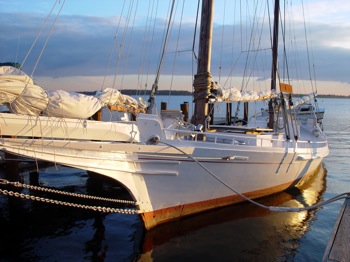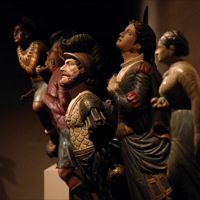
Photo courtesy Chesapeake Bay Maritime Museum
There is a magic allure to the sea, and maritime museums groups can hear inspiring tales of sailors, fishers and brave souls who make their livings by transporting goods. What you will find is a front row seat to American history.
Michael Valliant, director of marketing and media relations for the Chesapeake Bay Maritime Museum, described it this way: “In the times we live in now, thank goodness we have maritime museums, because we need someone to tell those stories. There is, perhaps, no other collection of stories that are so connected to all of our history and how we developed as a nation.”
Chesapeake Bay Maritime Museum
St. Michaels, Maryland
The Chesapeake Bay Maritime Museum is located on an 18-acre waterfront campus on the Miles River where boat building and fisheries once thrived. The museum captures that past and the history of the bay.
 |
| Courtesy Chesapeake Bay Maritime Museum |
“Besides our working boatyard where shipwrights restore historic vessels and present interactive programs, there are 10 exhibit buildings to explore,” said Valliant.
Those buildings include a waterman’s shanty, where visitors try their best to harvest oysters; a water-fowling structure, where a master carver creates decoys; and a building dedicated to the nation’s most complete collection of Chesapeake Bay artifacts, visual arts and indigenous watercraft. Pleasure boaters also appreciate an exhibit on recreational water activities and how they’ve changed over the past 100 years.
Energetic visitors can climb to the top of the 1879 cottage-style lighthouse to enjoy views of the harbor, perhaps while visiting during June’s Antique and Classic Boat Festival or July’s Chesapeake Folk Festival, a celebration of music, food and fun.
(410) 745-2916
www.cbmm.org
Columbia River Maritime Museum
Astoria, Oregon
The official maritime museum of Oregon, the Columbia River Maritime Museum has six galleries, a Great Hall and the Lightship Columbia, a floating lighthouse.
 |
| Courtesy Columbia River Maritime Museum |
Groups are first introduced to the dangerous life of a bar pilot during the film The Great River of the West, in which a fierce winter storm threatens the lives of everyone on a vessel.
“That great river is, of course, the Columbia River, a 1,200-mile-long river that has been the lifeblood of our area,” said Dave Pearson, deputy director. “We are lucky that at the museum, huge windows allow the Columbia River to be a living backdrop for exhibits that allow visitors to pilot a tugboat, participate in a Coast Guard rescue and live in Astoria during the height of salmon fishing.
“Our Coast Guard display includes a 20-foot wave; it gives visitors such energy, because it’s real. We also have a World War II-era Navy destroyer, the USS Knapp, which offers groups the opportunity to walk aboard and sit in the captain’s seat.”
Coast Guard motor lifeboats, a trawler and gill-netter vessels are on display. Maritime collections also showcase models, paintings, gear, wardrobes, weapons and more.
(503) 325-2323
www.crmm.org
Great Lakes Shipwreck Museum
Whitefish Point, Michigan
The area of Upper Michigan around Whitefish Point has earned the ominous nickname Lake Superior Shipwreck Coast, because close to 600 shipwrecks are near there.
“Whitefish Point marks the critical turning point for all ships entering or leaving the lake,” said Chris Sams, business manager for the Great Lakes Shipwreck Museum.
“We have 12 different shipwrecks in our museum, along with countless artifacts and exhibits that bring to life the dramatic stories of those sailors and ships that not only braved the waters but sometimes lost their lives,” Sams said.
The most famous of those ships was immortalized by folksinger Gordon Lightfoot in the 1976 ballad “The Wreck of the Edmund Fitzgerald.” While steering for shelter at Whitefish Point in 1975, the large ore carrier and its crew of 29 were lost just 17 miles away. The ship’s 200-pound bronze bell, which was attached to the roof of the pilothouse, and a video documenting the raising of that bell in 1995 are part of the visitor experience.
Groups also tour the Whitefish Point Light Station, the oldest active lighthouse on Lake Superior, along with the 1861 keeper’s quarters that include period furnishings and artifacts.
“You’ll hear firsthand accounts of keepers and their families who manned this side-by-side duplex building while tending the light,” said Sams.
Sams added that bank groups can arrange for boxed lunches. “There is a beautiful boardwalk right on the shore to enjoy a picnic.”
(800) 635-1742
www.shipwreckmuseum.com
Lake Champlain Maritime Museum
Basin Harbor, Vermont
Before roads were constructed, Lake Champlain was the only option for transporting goods.
 |
| Courtesy Lake Champlain Maritime Museum |
“Even before Europeans were here, the indigenous people traveling in birch bark canoes used this body of water to survive,” said Eloise Beil, communications manager for the Lake Champlain Maritime Museum.
“Later, there were military battles with those who had an interest in keeping control of this waterway for survival and prosperity. Everything is tied together with Lake Champlain from the very beginning to the early 20th century.”
The museum has more than a dozen buildings with artifacts, video and audio displays, interactive stations and displays about the history of Lake Champlain, maritime history and nautical archaeology.
Groups also observe conservators working on preserving objects that have been discovered and raised from the depths of Lake Champlain, which has one of the largest concentrations of shipwrecks in the country.
Full-scale replicas of a Revolutionary War gunboat, the Philadelphia II, and a Colonial-era bateau, the Perseverance, offer visitors a chance to tour history firsthand.
New in 2010 is a structure housing nearly 40 small craft from different eras and an exhibit on Native American watercraft building.
Groups especially enjoy the Shipwrecks on Water Tour, which offers an exploration of a shipwreck site via an archaeologist and a remote camera. Beil added, “You’ll hear incredible human-interest stories.”
(802) 475-2022
www.lcmm.org
Mariners Museum
Newport News, Virginia
With more than 45,000 items inspired by human experiences with the sea, the Mariners Museum has one of the largest and most comprehensive maritime collections in the world.
The 60,000-square-foot museum, located on a 550-acre park on the James River, includes figureheads, antique navigational instruments and working steam engines.
Among the many permanent exhibits is the Miniature Ships of August F. Crabtree, a collection that depicts the evolution of boatbuilding from a primitive raft to a Venetian vessel decorated with 359 carved figures.
The International Small Craft Center showcases hundreds of authentic sea transports, from ornate gondolas to hand-carved arks to primitive rafts.
The museum is also the official repository for USS Monitor artifacts, which include its propeller, anchor and engine. The Monitor was the first ironclad warship commissioned by the U.S. Navy; it is most famous for its participation in the Battle of Hampton Roads in 1862 against the Confederate ironclad Virginia, the first battle between two ironclad ships in history.
(800) 581-7245
www.marinersmuseum.org
Mystic Seaport
Mystic, Connecticut
Since the 1600s, the area around Mystic, Connecticut, has been a center of shipbuilding.
 |
| Courtesy Mystic Seaport |
“At one time, we had 12 shipbuilders, and more than 600 vessels were constructed along the Mystic River,” said Michael O’Farrell, director of public relations for Mystic Seaport.
Mystic Seaport has three distinct areas on 19 acres. A re-created 19th-century seafaring village showcases dozens of buildings staffed with professionals who bring maritime history, crafts and stories to life.
“We have a tavern, of course, a schoolhouse, a general store —businesses that were essential in a maritime community. Seventy-five percent of the buildings are authentic,” said O’Farrell.
A working shipyard, home to the largest wooden whaling ship in the world, is where visitors can step on board and see masters at work.
“This is where the re-created Amistad was built. That vessel now cruises around the world,” O’Farrell said.
A more formal museum, brimming with paintings, models and vintage photography, is the third area. Groups can also experience the sea on a steamboat ride.
“Get out on the water,” advised O’Farrell. “This experience is an important part of what we do.”
(888) 973-2767
www.mysticseaport.org
Wisconsin Maritime Museum
Manitowoc, Wisconsin
The Wisconsin Maritime Museum is dedicated to commemorating the maritime history of the Manitowoc-Two Rivers area and the submarines built there during World War II. The museum is also a leader in preserving the maritime history of Wisconsin and the Great Lakes area.
“We have a huge heritage thanks to shipwrecks and fishing villages,” said Dawn Eggers, group sales coordinator.
The star attraction is the USS Cobia, a fully restored World War II submarine located on the active port outside the museum.
“Before the tour, groups are introduced to the six war patrols of Cobia, the important role submarines played in World War II and how Manitowoc came to build 28 submarines during the war,” said Eggers. “Groups can even spend the night on the submarine and learn firsthand what it would have been like to be a submariner during the war.”
The 60,000-square-foot museum offers a large collection of model ships and displays of historic vessels and marine engines. One operating steam engine is so large that the building had to be built around it.
“Visitors can even operate this engine,” said Eggers. “Many of our exhibits are interactive to offer the best in authenticity.”
(866) 724-2356, ext. 106
www.wisconsinmaritime.org









